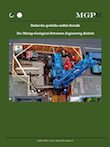Hydrochemical characteristics of the groundwaters in Prilep’s part of Pelagonia valley – Republic of Macedonia
DOI:
https://doi.org/10.17794/rgn.2018.3.11Keywords:
groundwater, Piper diagram, Chadha’s diagram, spatial distribution, Pelagonia valley, MacedoniaAbstract
This paper presents the results of hydrochemical investigations of groundwater from the Prilep part of the Pelagonia valley - Republic of Macedonia. These investigations were carried out by analyzing 12 samples of groundwater, taken from the exploitation wells. Samples are taken once a season, during August 2013. Values of the pH were determined with the field digital pH meter, while cations are determined by inductively coupled plasma-atomic emission spectrometry (ICP – AES). For the determination of the anions are used standard EPA methods (gravimetric - TDS, volumetric - Cl-, spectrophotometric - NO3-, NO2-, NH4+ and turbidimetric - SO42- with the spectrophotometer 6715 UV / VIS, Jenway). Тhe maps with spatial distribution of the hydrochemical components were prepared using the IDW (Inwerse Distance Weighting) method for map generation (Geographic Information System software (GIS) ESRI® ArcGis™ 9.2 and its extension Geostatistical Analyst). Spatial distribution maps were constructed according to the coordinates and sample content of each analyzed sample. Samples were taken from the wells which are divided into 3 groups: wells with free level with depth up to 10 m, wells with free level with depth up to 100 m and artesian wells. The graphical methods, Piper diagram and Chadha’s diagram, were applied in order to determine the hydrochemical properties of the groundwater. The results indicate that the groundwater samples have different hydrochemical properties. Ca 2+ >Na+>Mg2+ for the cations and HCO3- >Cl- >SO42- for the anions were dominantly dissolved ions in the majority of the water samples. Generally, increased values of Ca2+, Mg2+, Na+, K+, HCO3-, K+ and Cl- occur in the groundwater from deeper artesian wells, as a result of the longer retention time of water in the underground and its interaction with the geological environment. Dominant groundwater in Prilep field, in all three types of wells, are waters from hydrocarbonate class (HCO3¯), calcium group (Ca), the first type of water. Groundwater from the shallow wells show the increasing content of K+, NO3- and PO43-which indicates water pollution from fertilization of the cultivated areas, livestock farms as well as communal wastewater. Although hydrochemical data are obtained on the basis of water samples taken only once, they provide an indicative insight into the hydrochemical composition of the water. To obtain more reliable data, taking groundwater samples from wells should be performed multiple times in different seasons.
Downloads
Published
How to Cite
Issue
Section
License
Copyright (c) 2018 Rudarsko-geološko-naftni zbornik

This work is licensed under a Creative Commons Attribution 4.0 International License.
Creative Commons-BY
Authors who publish with this journal agree to the following terms:
In agreeing this form, you certify that:
- You read the ethical codex of the RGN zbornik available at journal web.
- You submitted work is your original work, and has not previously been published and does not include any form of plagiarism.
- You own copyright in the submitted work, and are therefore permitted to assign the licence to publish to RGN zbornik.
- Your submitted work contains no violation of any existing copyright or other third party right or any material of an obscene, libellous or otherwise unlawful nature.
- You have obtained permission for and acknowledged the source of any illustrations, diagrams or other material included in the work of which you are not the copyright owner.
- You have taken due care to ensure the accuracy of the work, and that, to the best of your knowledge, there are no false statements made within it.
- All co-authors of this submitted work are aware of, and in agreement with, the terms of this licence and that the submitted manuscript has been approved by these authors.
Publication licence
You retain copyright in your submitted work, according to journal license policy (CC-BY). By signing this form you agree that RGN zbornik may publish it under the publication licence. In summary the licence allows the following:
Anyone is free:
- To copy, distribute, display, and perform the work.
- To make derivative works.
Under the following conditions:
- The original author must always be given credit.
- The work may not be used for commercial purposes.
- If the work is altered, transformed, or built upon, the resulting work may only be distributed under a licence identical to this one.
Exceptions to the licence
In addition to publishing the work printed under the above licence, RGN zbornik will also enable the work to be visible online.
The journal editorial can change the licence rules anytime but it cannot retroactively restrict author(s) rights.


